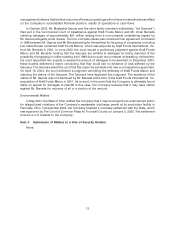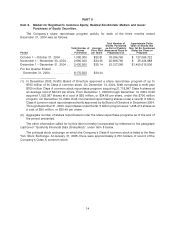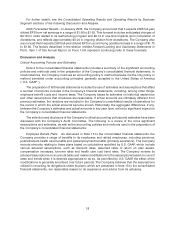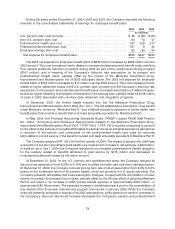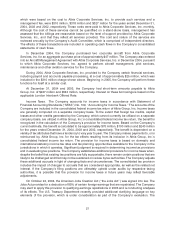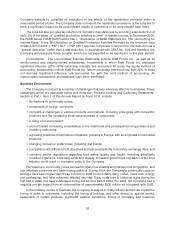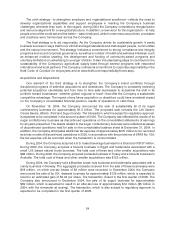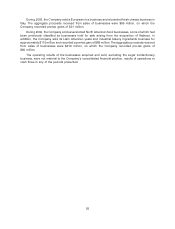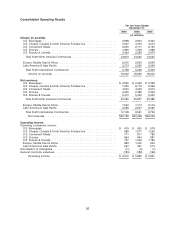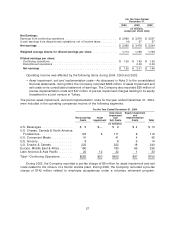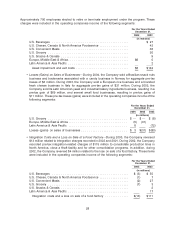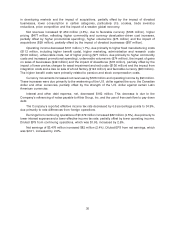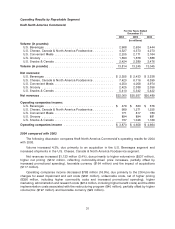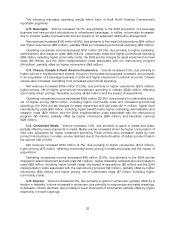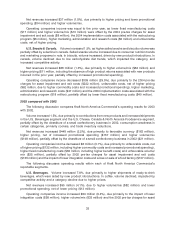Kraft 2004 Annual Report Download - page 24
Download and view the complete annual report
Please find page 24 of the 2004 Kraft annual report below. You can navigate through the pages in the report by either clicking on the pages listed below, or by using the keyword search tool below to find specific information within the annual report.incentive programs, customer inventory programs, Company initiatives to improve supply chain
efficiency, including efforts to align product shipments more closely with consumption by shifting some
of its customer marketing programs to a consumption based approach, financial situations of customers
and general economic conditions.
To build its business while confronting these challenges, the Company operates with seven
business strategies: 1) build superior consumer brand value; 2) build shopper demand through superior
customer collaboration; 3) transform the portfolio; 4) expand global scale; 5) drive out costs and assets;
6) strengthen employee and organizational excellence; and 7) act responsibly.
The first strategy—to build superior consumer brand value—involves improving the Company’s
products, using more value-added packaging, developing innovative new products and managing price
gaps effectively. During 2004, the Company increased marketing spending by approximately
$460 million versus 2003 to manage price gaps, to increase media presence, to drive growth, to
enhance brand equity and to support new products.
The second strategy—to build shopper demand through superior customer collaboration—
recognizes the importance of the Company’s retail partners in fulfilling its vision. The Company works
together with its customers to better understand consumer behavior in their stores, to develop in-store
programs that increase shopper demand, and to reduce costs through more efficient store delivery
systems.
The third strategy is to transform the portfolio. Through innovation, investment, acquisition and
divestiture, the Company is accelerating the shift in its portfolio toward businesses—whether global,
regional or local—that offer the Company a sustainable competitive advantage, and will better enable its
management to focus on opportunities that meet consumer needs and create long-term value for the
Company.
In particular, the Company is responding to growing consumer demand for products that meet
health and wellness and convenience needs. The Company is enhancing the nutrition profile of its
portfolio by creating new products and by reformulating existing products, including reducing or
eliminating trans-fat wherever possible. The Company is addressing convenience needs by offering
more convenient packaging, such as single-serve and resealable packaging, and products requiring
reduced preparation.
The fourth strategy—to expand the Company’s global scale—focuses on improving its growth
prospects in key developing markets that offer the greatest growth potential. In particular, the Company
is expanding its marketing and infrastructure investments in large, growing markets, such as China,
Brazil, Mexico and Russia.
The fifth strategy—to drive out costs and assets—includes the Company’s announced three-year
restructuring program, with the objectives of realigning and lowering its cost structure and optimizing
capacity utilization. As part of this program (which is discussed further in Note 3 to the consolidated
financial statements), the Company anticipates the closing or sale of up to twenty plants and the
elimination of approximately six thousand positions. From 2004 through 2006, the Company expects to
incur up to $1.2 billion in pre-tax charges, reflecting asset disposals, severance and other
implementation costs, including $641 million incurred in 2004. Approximately one-half of the pre-tax
charges are expected to require cash payments.
In addition, the Company expects to incur approximately $140 million in capital expenditures from
2004 through 2006 to implement the restructuring program, including $46 million spent in 2004. Cost
savings as a result of the restructuring program were approximately $127 million in 2004, are expected to
increase by an incremental amount between $120 million and $140 million in 2005, and are anticipated
to reach annualized cost savings of approximately $400 million by 2006, all of which are expected to be
used in supporting brand-building initiatives.
23


